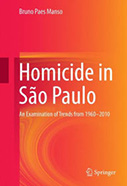Homicide in São Paulo: An Examination of Trends from 1960-2010

Author: Bruno Paes Manso
Publisher: New York: Springer, 2016. 189p.
Reviewer: Kimberly M. Pitts | May 2017
The homicide rate in São Paulo grew from 5.9 per 100,000 inhabitants in the 1960s to a peak of 59.4 in 1999. Starting in 2000, the rate gradually declined, reaching 18.1 in 2010. The alarming increase in the homicide rate in São Paulo, Brazil as well as the sudden decline has been well-documented. In Homicide in São Paulo: An Examination of Trends from 1960- 2010, Bruno Paes Manso combines decades of experience as a journalist interviewing homicide perpetrators and victim’s families with his expertise as a political scientist to add a more in-depth explanation for São Paulo’s homicidal phenomenon. What sets his study apart from other academic research is the focus on social phenomena that condoned a culture of violence for nearly forty years, before shifting to a condemnation of killing.
The author argues that São Paulo is unique from other Brazilian cities in the experience of a six-decade homicidal bell-shaped curve. São Paulo, particularly the eastern and southern regions, urbanized quickly and without order or infrastructure. The densely populated peripheral areas came to be perceived as criminal and were targeted by the military police. In fact, homicide rates have ranged from 3.6 in the central area to over 106 in the south. In the most economically disadvantaged areas, not only are young men more likely to be homicide victims, they are also disproportionately represented as perpetrators. The author further suggests that one of the things that set São Paulo apart from other areas was that until the mid-2000s, the criminal element was more individualistic and less organized. Individuals, not gang leaders or crime bosses, were the perpetrators of homicide.
Over fourteen chapters, enhanced with interviews mainly of homicide perpetrators, Manso not only identifies and elaborates upon three homicidal phases: the beginning, the proliferation, and the drop; he also explores those phases through three groups of killers: military police, vigilantes, and violent youth. He uncovers a “homicidal morality” that justified killing initially as a form of social cleansing and later as self-protection.
The author traces the onset of the increase in homicide to the military dictatorship which ruled Brazil from 1964 to 1985. In the late 1960s, after the coup, death squads, consisting of police and other state officials, emerged to fight and exterminate the criminal element in the city. They killed with impunity under a guise of establishing order, and justified the killing as a form of social control. Instead of mitigating homicide, death squads rather contributed to an increase in homicides.
During the early 1970s, death squads were replaced by military police who turned their attention to communist guerrillas. From the late 1970s to the end of the military dictatorship, military police, who also killed with impunity, transitioned from killing guerillas to targeting common criminals. Lack of police training and capability, alongside an established culture of violence resulted in an increasing homicide rate and a return to a social cleansing mentality. Testimony of former military police provide an insight into their attitude towards killing as they describe a culture in which killing criminals was encouraged. They openly recount instances in which they planted evidence, engaged in shootouts and other tactics to avoid legal repercussions for themselves. Their disdain for the civil police and frustration with the inadequacies of the legal system prompted the military police to take responsibility for protecting society by exterminating those they considered to be the bad element.
Through interviews with the residents from peripheral neighborhoods, readers learn that the early 1980s mark the beginning of a shift in peripheral communities. Makeshift communities, which had previously been considered safe areas, experienced an increase in thefts and robberies. A new tool of social control, vigilante groups, made up of working men from the community, organized to protect store owners and defend workers from the common neighborhood criminal. Vigilantes not only killed with impunity and often with the knowledge or help of the police, they worked in a homicide-tolerant environment. Several of the vigilantes interviewed reported that they started killing after seeing their wives, daughters or mothers raped. Vigilantes, whose homicidal cleansing lasted nearly a decade, were often seen as folk heroes. However, when they moved from protecting shop owners by killing criminals to extortion in the form of charging protection fees, they became targets of police.
The homicide rate continued to increase in the 1990s. An environment tolerant of homicides in the most violent communities resulted in a multiplier effect in which the law on the street was kill or be killed. Men in poor neighborhoods, some as young as 15 years old, targeted by vigilantes and authorities, retaliated with violence. Interviews with young homicide perpetrators revealed a continuation of the “morality of violence” belief that bad people deserved to die. Interpersonal conflicts surpassed criminal activity as the main motivational force for homicide. Revenge and drugs, particularly debt related to drugs, account for the main reasons for interpersonal homicide. The interpersonal nature of homicide resulted in cycles that could last decades and led to the formation of “sets,” gang-like groups who battled other neighborhood sets. Increased drug activity alongside a 500% increase in firearms contributed to a growth in deadly shootings. The influx of crack in São Paulo in the 1990s further affected the homicidal mentality as drug addicts became a target due to their perceived nature as snitches who could potentially endanger sets of killers. As with earlier homicides, the murder of crack addicts was justified as a social cleansing of the community trash. In fact, the 1990s saw an increase in massacres with crack addicts often being the target.
The homicide rate in São Paulo peaked in 1999 and began a steady decline to a low of 18.1 in 2010. Youth in the poorest communities experienced the most significant decline in killings. The author argues that after decades of homicides crippling families and neighborhoods, a “moral reconfiguration” occurred. New court, police, and prison policies, alongside a changing neighborhood attitude against violence perpetuated by hip-hop groups combined to dramatically reduce homicide. Manso found that even the organized crime group Primeiro Comando da Capital (PCC) had an effect on reducing homicide. The PCC, which was formed in 1993, promoted nonviolence particularly with other members and contributed to the overall reduction in homicide.
Homicide in São Paulo: An Examination of Trends from 1960- 2010 is an excellent supplement to the existing academic resources on the 60-year examination of the rise and fall of the homicide rate in São Paulo. Manso’s work contributes to the existing studies by using interviews of killers to explore the changing social nature of homicide. The book is most likely to appeal to political scientists, criminologists, sociologists and academics in Latin American studies.
While the book contributes to creating a more complete understanding of the homicidal phenomenon in São Paulo, addressing a few minor issues would make it an even more useful resource for readers. An introductory chapter briefly outlining the coup and the years following would have been helpful to readers who are not familiar with Brazil’s history. The theory and methodology chapter in which the author discusses social change, lack of legitimate authority and homicide, lends itself well to a discussion of Durkheim, particularly the concept of anomie. While the interviews added rich contextual material, the methodology does not appear to be systematic, and the analysis was lacking.
This book would also be improved with a more thorough editing. Although it does not take away from the content of the book, there are several grammatical mistakes, mainly in the form of missing articles, which are distracting to the reader. The chapters range from three or four pages to 20 or more, making the reading segmented and choppy. Some of the smaller chapters could be incorporated into the larger thematic ones contributing to a more complete understanding of groups of homicidal perpetrators. The font, particularly of the interview sections, is quite small. As the book is 189 pages, changing the font size would be a reasonable adjustment. The homicide rate for 1999 is reported as 59.4 in the introduction, and states that the data are from governmental health agencies. In a later chapter, the 1999 homicide rate is reported as 65.3 and cites the Health Ministry’s Morality Information Subsystem (SIM) as the source. The difference in the two rates is significant, and leaves the reader questioning the difference.
Despite the need for a more thorough editing of the book, Manso’s study contributes significantly to the field. His background as a journalist allowed him access to military police, vigilantes, and youth who were directly responsible for homicide. Through personal testimonies, he was able to examine social phenomena that contributed to a homicidal morality. Military police, vigilantes, and youth alike justified their homicidal behavior as ridding society of a proclaimed “other.” And, the insight into the decline of homicide, which explored areas beyond new police, court, and prison policies, is informative, showing that even hip-hop groups and prison gangs can have a positive effect on society.
Kimberly Mathis Pitts, Ph.D., Assistant Professor of Sociology, Campbellsville University


